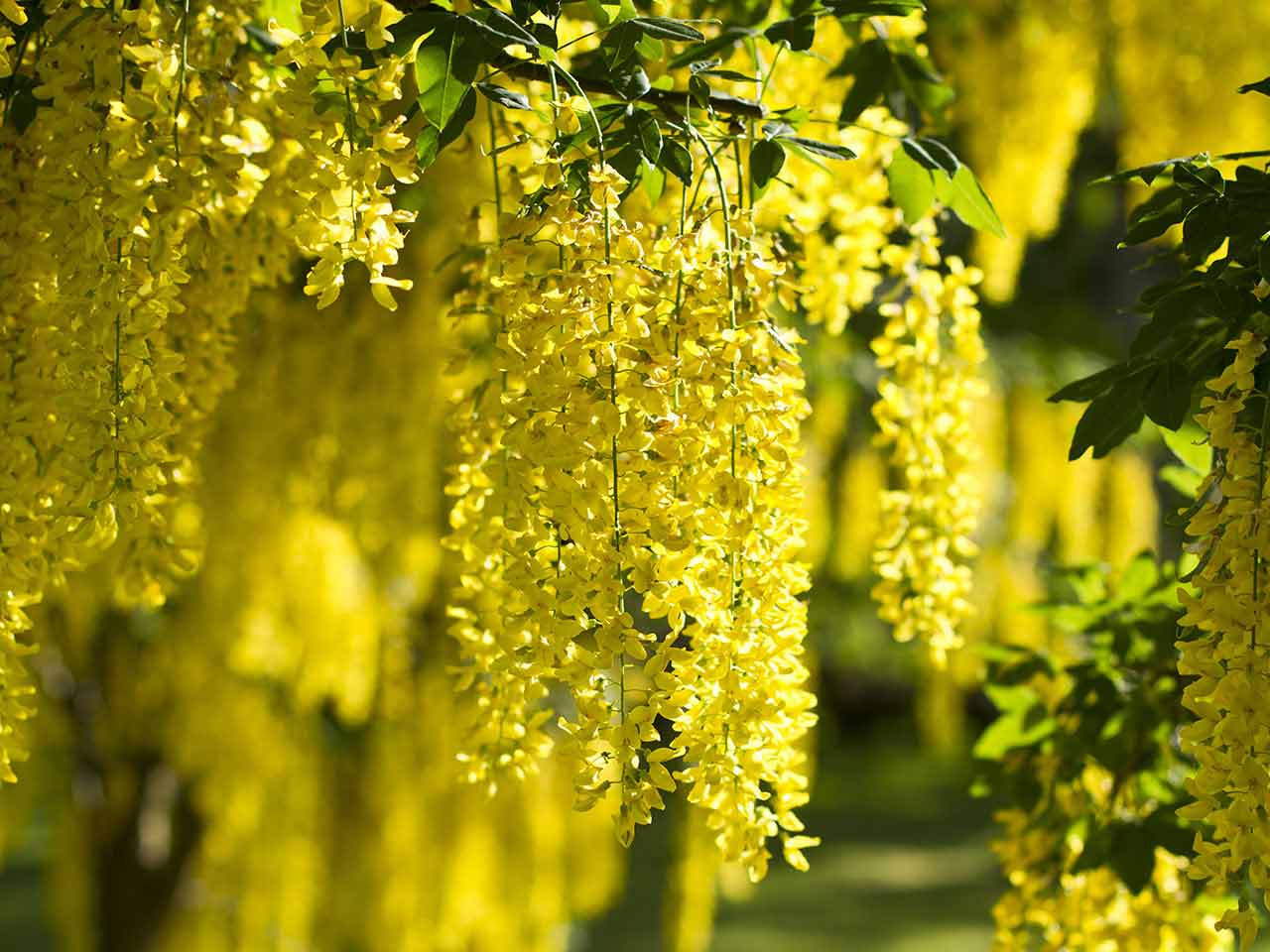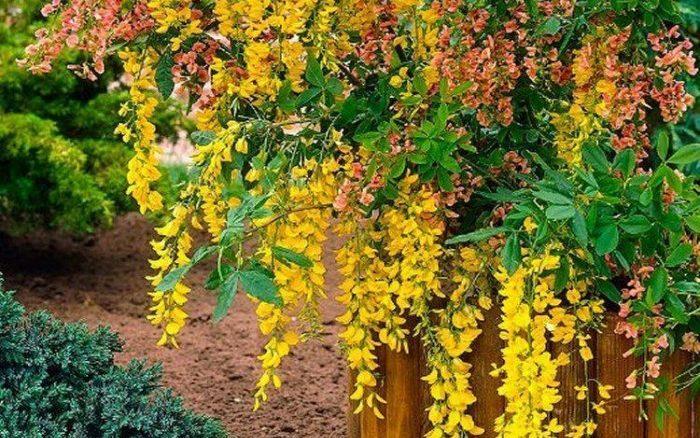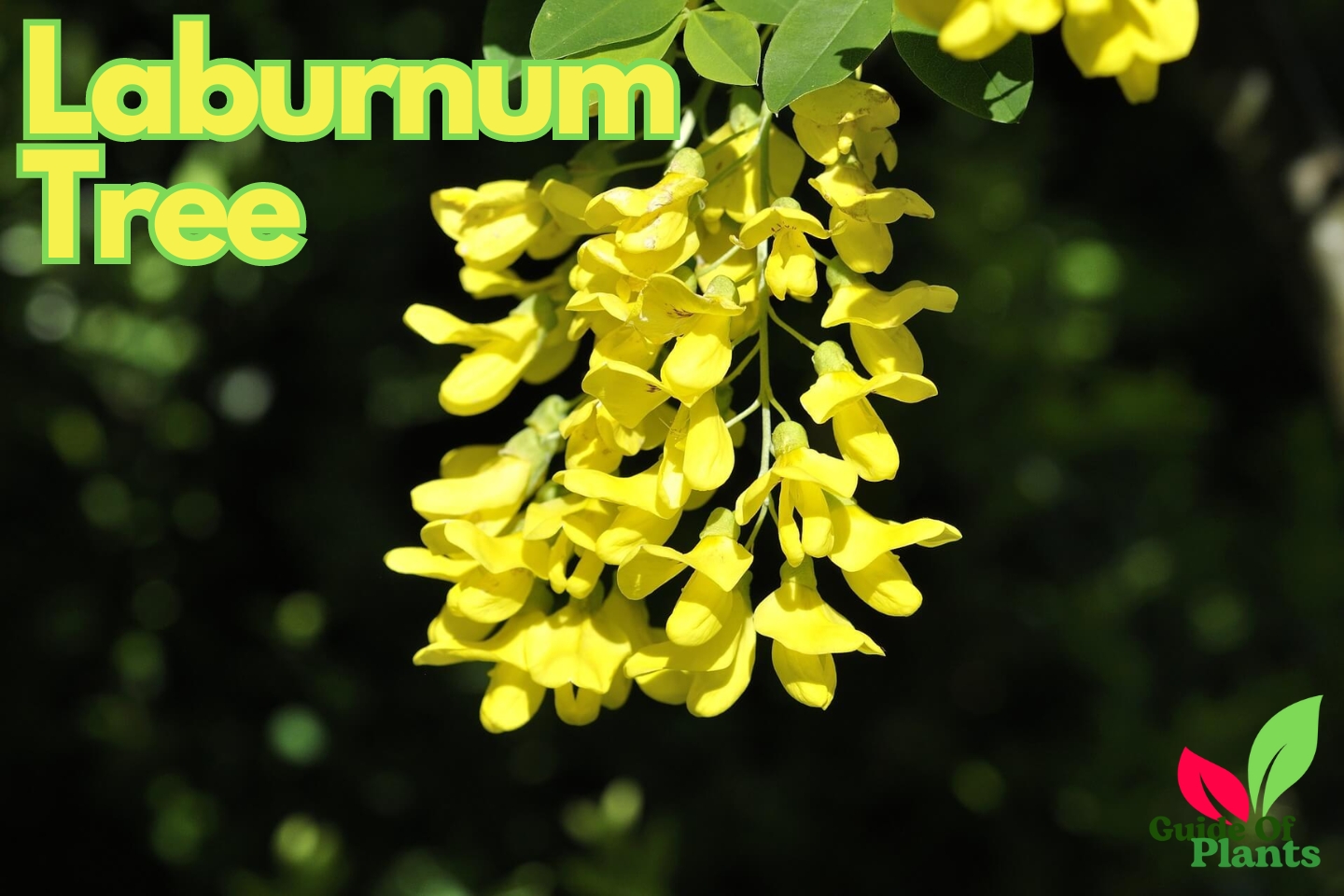The laburnum tree is a small, ornamental tree with golden yellow flowers that blooms in the spring. Laburnums are valued for their beauty and have long been a popular addition to gardens and landscapes. The laburnum’s cascading yellow blossoms provide a burst of color and interest to any setting.
The laburnum belongs to the genus Laburnum and family Fabaceae. There are three main species: Laburnum Anagyroides, Laburnum Alpinum, and Laburnum X Watereri. They are native to Europe and Asia.
Table of Contents
What is a Laburnum Tree?
The laburnum is a small, deciduous tree that is renowned for its graceful, drooping branches and its vibrant golden-yellow flowers. Laburnum trees are often referred to by their scientific name, Laburnum. They may also be called golden chain trees or golden rain trees.

Common Names for Laburnum
| Common Name | Characteristics |
| Golden chain tree | Named for the long, hanging clusters of yellow blooms that resemble a chain. |
| Golden rain tree | Refers to the long cascading blooms that resemble a “rain” of yellow flowers. |
The laburnum typically grows 15-20 feet tall and has a spreading, umbrella-like form. The dark green leaves are trifoliate, meaning there are three leaflets that attach to a central stalk. The smooth gray bark often shows interesting patterns of light and dark patches as it ages.
In the spring, laburnum trees produce an abundance of drooping clusters of bright yellow, pea-like flowers. These blooms last about a month and blanket the tree with color. They have a sweet fragrance that attracts pollinators like bees. The flowers later develop into pods that hold poisonous seeds.
Laburnum trees make a bold statement in any garden with their vibrant golden display. They grow well in zones 5-7 and prefer full sun exposure. With their graceful form and intense flower color, it’s easy to see why laburnums have been prized ornamental specimens for centuries.
Also Know About: The Strangler Fig Plant A Wonderful Creation Nature
How to Grow Laburnum
Growing laburnum trees can be highly rewarding. With their graceful form and stunning yellow blooms, laburnums make exceptional ornamental specimens in the home landscape. By providing the right conditions and care, you can successfully grow these beautiful trees.

Selecting a Planting Site
Choosing an appropriate planting site is the first step in growing healthy laburnum trees. Consider the following factors when selecting a location:
Sunlight Needs
Laburnums thrive best in full sun. Look for a spot that receives at least 6 hours of direct sunlight per day. Morning sun is especially beneficial. Dappled shade is tolerated, but too much shade will reduce flowering.
Soil Requirements
Laburnums prefer fertile, well-draining soil. The ideal soil pH is neutral to slightly acidic. Avoid planting laburnums in very wet or compacted soil. Amend the soil with compost or other organic matter to improve drainage before planting.
Room to Grow
Allow enough space for the laburnum to reach its mature size. Laburnums generally grow 15-20 feet tall and 10-15 feet wide. Give the tree at least 15-20 feet of space on all sides to prevent overcrowding.
Planting Laburnum Trees
Spring is the best time to plant container-grown laburnum trees. Follow these tips for proper planting:
- Dig a hole 2-3 times wider than the root ball. The hole should be only as deep as the height of the root ball.
- Carefully remove the tree from the container and loosen any encircling roots.
- Place the tree in the hole and backfill with the soil. Firm the soil gently around the base.
- Water thoroughly after planting and apply a 2-4 inch layer of mulch around the base.

Aftercare
Regular watering is crucial while the laburnum is established. Water young trees 1-2 times per week during dry periods. After the first year, established laburnums are quite drought tolerant.
Caring for Laburnum Trees
Proper care and maintenance will keep laburnum trees healthy and support maximum flower production. Key aspects of laburnum care include:
Watering
- Water regularly during the first year after planting. Provide 1-2 inches of water per week.
- In subsequent years, provide supplemental water during droughts. Deep weekly soaking is better than frequent light watering.
Fertilization
- In spring, apply a balanced, slow-release fertilizer following label directions. Avoid over-fertilization.
- Top dress with compost or manure each fall to nourish the soil.
Pruning
- Prune laburnums soon after flowering to shape and maintain the plants.
- Remove any diseased, damaged or crossing branches.
- Shorten overly long branches to encourage dense growth habits.
- Remove suckers and watersprouts that emerge from the rootstock.
Pest and Disease Control
- Laburnums have few serious pest problems. Aphids, scale, leaf spot may occur.
- Promote vigor through proper care. Remove affected parts promptly.organic insecticides if needed.
With the right growing conditions and care, laburnums will flourish and delight the garden with their colorful floral display each spring. Be sure to cite them appropriately and attend to their seasonal water and nutritional needs. Some pruning for shape and plant health will allow laburnums to fully showcase their graceful elegance.
Propagating Laburnum Trees
Gardeners who already have a laburnum tree may wish to propagate additional plants. Laburnums can be propagated by seed or by cuttings:

Propagation by Seed
- Collect pods when they turn brown and seeds rattle inside. Air dry pods further and remove seeds.
- Sow seeds 1⁄4 inch deep in fall or stratify seeds by cold treatment prior to spring planting.
- Germination often takes 2+ seasons. Transplant seedlings when large enough to handle.
Propagation by Cuttings
- Take 6-8 inch tip cuttings from new growth in early summer. Strip bottom leaves.
- Dip cut end in rooting hormone and plant in potting mix. Place in a bright area, not direct sun.
- Most frequently to keep humid. Rooting takes 1-2 months. Transplant young plants to the garden.
With patience, new laburnum specimens can be grown from seeds or cuttings of existing trees. This allows gardeners to reproduce treasured plants.
Also Know About: The Silk Floss Tree, Nature’s Remarkable Gift To Life

Varieties of Laburnum
There are three primary species and several cultivars of laburnums available:
Laburnum Anagyroides (Common Laburnum)
- Reaches 20-30 feet tall with a graceful, spreading form.
- Long, hanging clusters of bright yellow flowers in spring.
- Tolerant of heat, humidity and coastal conditions.
Laburnum Alpinum (Scottish Laburnum)
- More compact tree, 10-15 feet tall. Rounded form.
- Abundant pale yellow blooms in spring on short racemes.
- Thrives in cooler climates. Tolerates partial shade.
Laburnum X Watereri (Vossi Laburnum)
- Hybrid between the two species above.
- 15-20 foot height. Profuse, intense yellow blooms.
- Blooms up to one month later than other laburnums.
- Popular cultivars include ‘Vossi’, ‘Sunspire’, and ‘Plena’.
Gardeners should choose a laburnum variety suited to their climate and space limitations. The spectacular spring bloom colors will enhance any landscape.
With proper site preparation, planting, and care, laburnums make outstanding ornamental additions to gardens and yards. Their vibrant yellow flowers and graceful branching structure provide elegance and interest. By following some simple guidelines, even novice gardeners can successfully grow laburnums. The glowing floral cascades will repay the efforts with years of beauty.
Symbolism of the Laburnum Tree
The vibrant golden yellow flowers of the laburnum tree have led to it being associated with qualities like beauty, joy, and new beginnings throughout cultures.
Representing Happiness and Vitality
In many cultures, the laburnum has come to symbolize happiness and the life-giving energy of spring. Its abundant blossoms coincide with the renewal of nature, conveying a sense of vibrancy and vigor.
For example, in Celtic legends, the laburnum was linked to the tree of life and the goddess Cerridwen. Its bright flowers represented vitality and fulfillment.
Celebrating Beauty and Grace
The stunning floral display of laburnums is often seen as representing beauty. The long, graceful panicles of rich yellow blooms are prized for their ornamental elegance.
In the Victorian era, laburnums were admired for their picturesque qualities and ability to create a focal point in the garden. The drooping branches evoke a delicate, feminine grace.
Conveying Joy and New Beginnings
Across cultures, the emergence of laburnum flowers in spring has come to symbolize renewal and fresh starts. The radiance of their color conveys cheerfulness, optimism, and joy.
For many, the laburnum’s blooms are a reminder that brighter days are coming after winter’s gloom. Their luminosity and promise of warmer seasons ahead give them an uplifting spirit.

Benefits of the Laburnum Tree
In addition to their aesthetic appeal, laburnums provide ecological benefits that support garden health.
- Attracting Pollinators: The sweet nectar and pollen of laburnum flowers draw in a diversity of beneficial pollinating insects like bees, butterflies, and hummingbirds. This supports healthy local ecosystems.
- Promoting Biodiversity: The presence of laburnums enhances overall garden biodiversity. Birds often nest in laburnum branches, while squirrels and chipmunks eat fallen seeds.
- Supporting Soil Health: As a legume, laburnums form symbiotic relationships with soil bacteria to help fix nitrogen. This improves soil fertility. The trees also promote good drainage and aeration through their deep root systems.
Incorporating laburnums into garden spaces contributes beauty while also nurturing ecological balance and diversity through their interactions with native wildlife.
Also Know About: Dragon’s Blood Tree The Nature’s Wonder
Laburnum Tree Poisonous Characteristics
While stunningly beautiful, laburnums do contain toxic elements that require caution.
Poisonous Alkaloids: All parts of laburnum trees, including the flowers, contain alkaloids such as cytisine. These compounds can cause vomiting, drowsiness, and even death if ingested.
Toxicity Risks: The risks of laburnum poisoning are highest for children, who may be attracted to the colorful seeds. Laburnum toxicity can also affect pets who ingest fallen parts.Handling laburnum plant materials may occasionally result in skin irritation or allergic reaction in sensitive individuals.
Safety Precautions: When growing ornamental laburnums, it’s important to take precautions:
- Plant trees away from children’s play areas and sidewalks.
- Maintain tidy grounds by removing fallen plant debris promptly.
- Educate children and supervise play around laburnums.
- Keep pets away from laburnums.
With sensible precautions, gardeners can safely enjoy the benefits and beauty of laburnum trees. Being aware of their potential toxicity allows proper management of these ornamentals.

Features of the Laburnum Tree
Laburnums have some key identifiable features and characteristics. Getting to know the anatomy and traits of these ornamentals helps appreciate their beauty.
Overall, laburnums are small, deciduous trees with spreading canopies. They have trifoliate leaves which consist of three leaflets joined at a central stalk. The bark is thin and smooth with interesting mottled patterns in gray, green, and brown.
However, the most striking feature of laburnums is the cascading clusters of vibrant yellow pea-like flowers that emerge in spring. These elongated panicles can grow over a foot long, drooping gracefully from the branches and blanketing the trees with color.
The flowers later develop into flattened seed pods about 2-4 inches long. The pods contain toxic black seeds. Like other legumes, the seeds form within pods along the stems.
In terms of size, most laburnum trees reach 15-20 feet tall and 10-15 feet wide when mature. Their growth rate is moderate, averaging about 1-2 feet per year. With proper care, laburnums can live 40 years or longer.
Unique Characteristics of a Specific Laburnum Tree

One unique laburnum that stands out grows beside a historic schoolhouse in central Virginia. This particular tree is estimated to be over 80 years old.
What makes this laburnum unusual is its enormous size. It towers at around 40 feet tall, doubling the expected height. Over decades, its canopy has spread to engulf nearly 50 feet of ground space.
The tree’s great size allows it to produce a truly spectacular floral display each spring. Its cascading yellow blooms are visible from hundreds of feet away, cascading down in copious curtains.
This venerable laburnum is now a distinctive landmark in the community. Its immense presence and the radiance of its flowers make it unforgettable.
The tree serves as a living reminder of the schoolhouse’s history. Its graceful beauty has inspired generations of students over the years. This magnificent laburnum’s advanced age, size, and splendor give it a special significance.
Significance of Yellow in the Poem “Laburnum Tree”
The reference to the laburnum tree in the poem’s title suggests that the vibrant yellow color of the tree’s flowers plays a key symbolic role.
Yellow is often associated with sunshine, warmth, and light. The radiance of the laburnum’s golden blooms may represent joy, happiness, or hopefulness. Their emergence in spring aligns with renewal and new beginnings.
Alternatively, yellow can symbolize caution or betrayal in some contexts. If these meanings are explored, the poem may use the laburnum to evoke turbulent emotions or relationships.
Without analyzing the full poem, it is difficult to ascertain the precise symbolic meaning of the yellow laburnum flowers. But they likely reflect deeper themes related to emotion, relationships, the seasons, or the tree’s poisonous paradox.
Detailed analysis would be required to discuss how the laburnum’s yellow connects to characterization, mood, and motif in the specific poem. The tree potentially represents something about the speaker, their experiences, or perspectives on life.
Please provide the full poem text and any additional background to assist with a more in-depth assessment of how the laburnum and the color yellow are utilized in the imagery and symbolism. A scholarly analysis requires reviewing the actual literary work.

Laburnum Tree as a Flowering Tree
The laburnum tree is indeed classified as a flowering tree. It is prized by gardeners for its ornamental floral displays.
In spring, laburnums produce an abundance of bright yellow, pea-shaped flowers on long, cascading panicles. The flowering racemes dangle gracefully from the branches, containing dozens of small, delicate blooms.
The tree’s blooming period is relatively short, typically lasting around one month in late spring. In temperate areas, laburnums usually flower in May and June when conditions are mild and humid.
When in full bloom, a mature laburnum is covered in hundreds of vibrant yellow blossoms. Their golden color is stunning against the dark green foliage backdrop. The floral show is the laburnum’s most distinctive signature feature.
So while the laburnum has attractive leaves and form, its desirability as an ornamental specimen is primarily owed to its prolific yellow springtime blooms. The cascading flowers contribute to its status as a popular flowering tree.
Also Know About: Sandalwood Tree: A Nature’s Gift for Health, Beauty, and Serenity

Conclusion
The magnificent laburnum tree holds a special place in many gardens thanks to its graceful beauty and ornamental appeal. With its cascading golden chains of flowers in spring, the laburnum provides a spectacular floral display.
As covered in this article, laburnums have some specific growing requirements, including full sun exposure and well-draining soil. With proper care, they can thrive for decades. While toxic if ingested, laburnums pose little risk with sensible precautions.
Beyond aesthetics, laburnums offer ecological benefits. Their flowers support pollinators while their roots improve soil health. Laburnums contribute year-round interest with their captivating bark patterns and branching structure.
The vibrant yellow blossoms of laburnum trees have inspired many over the centuries. These stunning flowering trees evoke happiness and beauty across cultures. Their radiance breathes life into gardens after winter dormancy.
For those with space to accommodate their graceful spread, planting a laburnum can be a rewarding choice. With minimal care, gardeners can enjoy an eruption of golden springtime rain each year as these specimens mature. The laburnum’s elegant charm is truly mesmerizing in full bloom.



